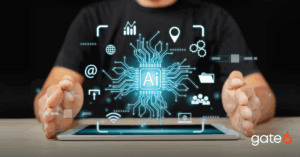5 Ways to Turn Big Data into Smart Data

What is Smart data and why does it matter
To understand Smart Data we must first begin by defining Big Data. Big data encompasses vast amounts of structured and unstructured information, but its sheer volume can be overwhelming and make extracting meaningful insights challenging. Smart data, however, refers to data that has been processed, filtered, and analyzed to yield actionable insights.
Turning big data into smart data is not just a technical challenge—it’s a strategic imperative. Smart data empowers organizations to:
- Make data-driven decisions with confidence.
- Enhance operational efficiency.
- Create personalized customer experiences.
- Innovate and stay ahead of competitors.
By leveraging the right tools, skills, and strategies, businesses can harness the full potential of their data assets. At Gate6, we specialize in helping organizations navigate this transformation, ensuring that their data initiatives deliver maximum value.
At Gate6, we understand the importance of this shift and have helped organizations unlock the true potential of their data assets. Here are five practical ways to turn big data into smart data:
1. Searching the Right Data
Not all data is equally valuable, so step one is identifying the most relevant data sources. To put the “smart” into your data it is also essential to prioritize information that directly impacts your business goals. For instance, analyzing customer behavior, market trends, or operational metrics can reveal patterns that help refine your strategies.
2. Filtering the Data
Cleaning and refining data are critical steps to ensuring high-quality analysis. Filtering the noise and irrelevant information involves removing outliers, duplicates, and incomplete data points while standardizing formats for consistency. By doing so, businesses can eliminate distractions, uncover previously hidden (and valuable) insights and focus on actionable information.
3. Using the Right Tools and Skills
Have you heard the saying “Use the right tool(s) for the job”? Same goes for expertise. Advanced analytics platforms and data visualization tools can simplify complex datasets and make insights… well, more visible. Additionally, having a skilled team proficient in data science, statistical analysis, and machine learning ensures that your organization can effectively interpret and leverage data insights.
4. Analyzing the Information
Once your data is cleaned and organized, it’s time to apply analytical methods to uncover patterns and insights. This involves looking into the past and doing some fortunee telling for the future. Descriptive analytics can help you understand past trends, while predictive analytics can forecast future outcomes. By employing these methods, businesses can identify opportunities, mitigate risks, and make proactive decisions.
5. Turning Smart Data into Strategy
The final step in the transformation process is translating insights into strategic actions. Smart data should inform decision-making, optimize operations, and enable targeted marketing campaigns. For example, businesses can use data-driven insights to refine customer experiences, streamline supply chains, or launch personalized advertising initiatives.
Conclusion
In a world where data drives progress, the ability to convert big data into smart data is crucial for staying competitive. By focusing on relevant data sources, filtering out noise, using advanced tools and skills, applying robust analytics, and turning insights into strategy, businesses can unlock new opportunities for growth and innovation. Gate6 is proud to support organizations on this journey, providing the expertise and solutions needed to turn raw data into a powerful strategic asset. Ready to make the shift? Partner with us to transform your big data into smart data today.
Contact us to learn how we can help you transform your data into actionable insights and achieve your business goals.
Relevant Posts
December 3, 2025
Must-Have AI Features to Build Smarter, Scalable Digital Products
August 19, 2025
AI Regulation – A “Short” Primer
August 13, 2025
Right-sizing Machine Language
August 11, 2025






